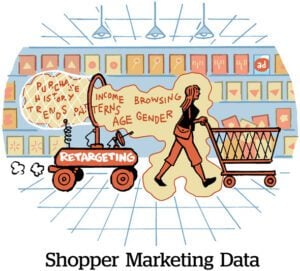Since advertisers now treat connected TV more like a digital performance channel, expect programmatic CTV demand to keep ramping up – including in the open exchange.
Even though programmatic still “plays second fiddle” to direct deals, more advertisers turn to programmatic because it’s a cost-effective way to target and attribute ads without sacrificing scale, said John Bishop, VP of market intelligence at Advertiser Perceptions.
Programmatic isn’t foolproof, though.
Despite its promise of simplicity and efficacy, CTV advertising comes with transparency problems and convoluted supply paths, which nearly all advertisers complain about, said Tom Stentiford, chief delivery officer at data consultancy DAS42.
So, Stentiford continued, expect to “see more disintermediation happen in 2024.”
Satisfaction guaranteed
CTV was pushed into performance marketing partially by the availability of conversion-based data for campaigns. But the trend was also spurred on by demands for cost efficiency, especially during cruddy economic conditions. This helped elevate programmatic CTV during the 2023 upfront season.
“Many advertisers are asking [programmers] to accommodate programmatic in the upfronts,” said Leo O’Connor, Paramount’s SVP of advertising. It’s possible to keep the “spirit” of the upfronts alive with budget commitments while allowing some programmatic execution for those commitments, he said.
Last year, the most popular choice for most buyers and sellers was programmatic guaranteed deals, which are essentially digitized insertion orders that automate campaign delivery. (Old habits die hard.)
But in 2024, the scales might tip further toward private marketplace (PMP) deals.
Making a marketplace
PMPs are increasingly popular because the media is biddable, so buyers can nab inventory at competitive prices compared to programmatic guaranteed deals, which come at a markup because they’re guaranteed placements.
Programmatic guaranteed doesn’t fulfill all the promises that attract advertisers to CTV, though, said Lara Koenig, global head of product at MiQ.
Instead, more advertisers are turning to PMPs because they can layer specific audience targeting onto CTV ad buys across a range of publishers, said Amy Leifer, chief ad sales officer at DirecTV. (Direct buys – including programmatic guaranteed deals – hinge on one publisher’s or broadcaster’s data.)
Targeting data improvements goes hand in hand with more detailed measurement, which is why Advertiser Perceptions’ Bishop said brands with bigger budgets are keen to spend more on PMP deals in 2024.
Better attribution helps justify higher investment, too. After all, the whole point of programmatic is to “increase the probability of conversions” within a specific audience target, said DAS42’s Stentiford.

Open to the open exchange?
Speaking of biddable, there’s also optimism for CTV supply entering the open exchange.
The open exchange has been something of a “naughty word,” said Koenig, referring to buy- and sell-side fears of risk and fraud. But now, she said, the programmatic potential for cost efficiency at scale is causing more marketers to “explore what’s out there.”
For example, MiQ started getting requests last year from political marketers to test open exchange CTV – “the first time a marketer client [of MiQ] has asked for it,” Koenig said.
Political advertisers are generally cautious with new channels, but they’re energized now to find “as much addressability as possible” from ad buys, Koenig said.
Programmers are also warming up to the idea of putting supply in the open exchange, since it helps backfill unsold inventory.
Though buying through the open exchange is still in the early stages, Koenig said, she expects it to become a much bigger trend throughout 2024.
Betting on biddable
Biddable programmatic is no silver bullet. It still lacks transparency, for one thing.
A streaming service, broadcast distributor and smart TV manufacturer could each have rights to sell ad inventory within the same piece of content, which causes problems like high frequency and lack of competitive separation, especially when multiple resellers are involved. A higher standard for transparency – especially in terms of where supply actually comes from – is a must if advertisers are to shift more ad budgets to biddable CTV supply.
Which is why MiQ only works with SSPs that have strict seller inclusion lists for open exchange CTV testing, Koenig said.
Specifically, for political advertisers who choose to test, MiQ only buys open exchange CTV impressions with app bundle IDs, which include information about the publisher and content genre so advertisers can confine campaigns to particular apps or content.
The next step for CTV open exchange buying is to “put more pressure on verification partners” to improve brand safety and viewability tracking, Koenig said.
Cleaning up the supply path

Verifying and cleaning CTV supply is no small task, though.
The sheer number of SSPs and DSPs that process CTV inventory makes it hard for buyers to manage supply sources. This problem is “why supply-path optimization is such a big deal these days,” DirecTV’s Leifer said.
The result is that both SSPs and DSPs are trying to woo new advertiser clients by promising a more direct path to CTV supply, like what we’ve seen with The Trade Desk’s OpenPath and Magnite’s ClearLine.
And the pressure is especially intense for SSPs, since they also must compete among themselves.
Major SSPs, like Magnite and FreeWheel, tout the fact that they also have ad servers, for example, because closer links between CTV supply and campaign activation lowers the possibility of mistargeting or repeat ads. Challenger SSPs, meanwhile, try to stay afloat by promising lower CPMs.
Right now, programmatic CTV is still at a “midpoint in maturity,” Koenig said. But “competition breeds innovation,” she said, which is why supply-path optimization also has a prominent place on the list of programmatic trends to watch in the CTV space throughout 2024.


















